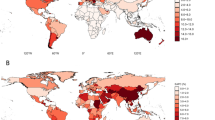Conclusion
As the need grows to understand how health care can be targeted, in the relative absence of money price, to those who need it most, studies on the effects of travel distance and other measures of time price will become increasingly important. And in order to assure the equitable distribution of services it will also be important to understand how travel distance is ade facto rationing mechanism. The methods used in this investigation easily could be applied to subscribers of Health Maintenance Organizations to determine the effect of travel distance on the utilization of preventative medical services as opposed to more expensive secondary and tertiary care.
Out-of-pocket payments for health care are relatively insignificant for many people for many different reasons. In order to ration scarce services and in order to plan for the implementation of health, mental health, and other human service policies it is important to understand what other factors apart from money act as prices in the demand for services. Travel distance as a surrogate for time price, as we have seen, plays a significant role in the demand for mental health services. Time has value to us; it is worth something. And time must be given up in order to attain certain things and services so that some benefit can be derived from them. This is really rather a simple notion, but one that is too often overlooked. The idea that price has to do with more than just money (which is, after all, something of man's own making) is well expressed by Adam Smith inThe Wealth of Nations where he writes: “The real price of every thing, what every thing really costs to the man who wants to acquire it, is the toil and trouble of acquiring it.”
Similar content being viewed by others
References
Acton, J.P. Demand for Health Care Among the Urban Poor, With Special Emphasis on the Role of Time. Santa Monica: Rand Corporation, Report Number R-1151-OEO/NYC, 1973a
Acton J.P. Demand for Health Care When Time Prices Vary More Than Money Prices, Santa Monica: Rand Corporation, Report Number R-1189-OEO/NYC, 1973b.
Becker, G.S. A Theory of the Allocation of Time.Economic Journal.75 493–517, 1965.
Grossman, M.The Demand for Health: A Theoretical and Empirical Investigation. New York: Columbia University Press, 1972.
Holtmann, A.G. and E.O. Olsen.The Economics of the Private Demand for Outpatient Health Care. Washington, D.C.: John E. Fogarty Center for Advanced Studies in Health Sciences, U.S. Department of HEW Publication No. (NIH) 78–1262, 1978.
Kennedy, P.A Guide to Econometrics. Cambridge: The M.I.T. Press, 1979.
McGuire, T.G.Financing Psychotherapy: Cost, Effects, and Public Policy. Cambridge: Ballinger, 1981.
Mechanic, D.Mental Health and Social Policy. Second edition. Englewood Cliffs; Prentice-Hall, 1980.
Mirer, T.W.Economic Statistics and Econometrics. New York: Macmillan Publishing Co., 1983.
Okun, A. M.Equality and Efficiency: The Big Tradeoff. Washington, D.C.: The Brookings Institution, 1975.
Phelps, C.E. and J.P. Newhouse. The Effects of Coinsurance on Demand for Physician Services. Santa Monica: Rand Corporation, Report Number R-976-OEO, 1972.
Phelps, C.E. and J.P. Newhouse. Coinsurance, the Price of Time, and the Demand for Medical Services.Review of Economics and Statistics (56)3:334–342, 1974.
Pindyck, R.S. and D.L. Rubinfeld.Econometric Models and Economic Forecasts. Second edition. New York: McGraw & Hill, 1981.
Additional information
Stephen L. White, Ph.D. is Associate Professor of Health Policy and Management, College of Public Health, University of South Florida, 13301 North 30th Street, Tampa, FL 33612. The author is grateful to Ralph Berry, Ph.D. and Thomas G. McGuire, PhD. for comments on an earlier version of this paper. He is also grateful to the Northern Rhode Island Community Mental Health Center for access to data.
Rights and permissions
About this article
Cite this article
White, S.L. Census tract of residence and the use of C.M.H.C. services. Administration in Mental Health 13, 275–284 (1986). https://doi.org/10.1007/BF00836907
Issue Date:
DOI: https://doi.org/10.1007/BF00836907




